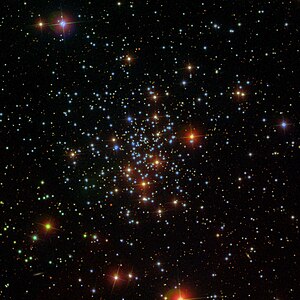NGC 2420

|
|
| SDSS , angle of view 13.2 '× 13.2' | |
| AladinLite | |
| Constellation | Twins |
|
Position equinox : J2000.0 |
|
|---|---|
| Right ascension | 07 h 38 m 23.9 s |
| declination | + 21 ° 34 ′ 27 ″ |
| Appearance
|
|
| classification | I2r |
| Brightness (visual) | 8.3 mag |
| Brightness (B-band) | 9.0 mag |
| Angular expansion | 6.0 |
| Number of stars | > 300 |
| Brightest star | 11 likes |
| Redness ( excess color E (BV)) | 0.054 ± 0.004 |
| Physical data
|
|
| Affiliation | Milky Way , about 3000 light years above the Galactic Disk |
| distance | 10000 ly (3085 pc ) |
| diameter | 30 ly |
| Age | 2.0 ± 0.2 billion years |
| Metallicity [Fe / H] | approx. −0.3 |
| history | |
| Discovered by | William Herschel |
| Discovery time | November 19, 1783 |
| Catalog names | |
| NGC 2420 • C 0735 + 216 • OCl 488 • Mel 69 • Cr 154 • Lund 364 • GC 1549 • H VI 1 • h 458 • Raab 56 | |
NGC 2420 is the name for an open star cluster in the constellation Gemini . It is around 10,000 light years from the Sun and has around 700 member stars. Since the cluster moves through the less dense outer regions of the Milky Way during its entire orbit around the galactic center , it could reach the old age of two to four billion years.
NGC 2420 has an angular diameter of 6 arc minutes and a visual apparent magnitude of 8.3 mag.
The star cluster was discovered on November 19, 1783 by Friedrich Wilhelm Herschel .
Web links
- NGC 2420. NOAO